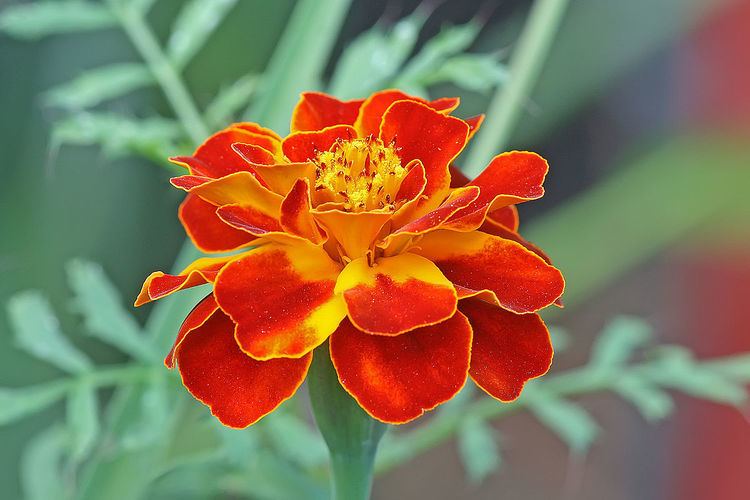Tribe Tageteae Species T. patula | ||
 | ||
Tagetes patula, the French marigold, is a species in the daisy family (Asteraceae). It is native to Mexico and Guatemala with several naturalised populations in many other countries.
Contents
Physical characteristics
The flower is an annual, occasionally reaching 0.5 m by 0.3 m. In some climates it flowers from July to October. In its native habitat of the highlands of central Mexico, blooms are produced from September to killing frost. Achenes ripen and are shed within two weeks of the start of bloom. The heads contain mostly hermaphrodite (having both male and female organs) florets and are pollinated primarily by beetles in the wild, as well as by tachinid flies and other insects. The leaves of all species of marigold include oil glands. The oils are pungent.
Uses
Used mainly as an edging plant on herbaceous borders, it is a low-growing plant with flowers of blended red and yellow in most varieties. French marigolds are commonly planted in butterfly gardens as a nectar source.
Medicinally, many cultures use infusions from dried leaves or florets.
Research also suggests that T. patula essential oil has the ability to be used as residual pesticide against Bedbugs. [2]
Culinary
The dried and ground flower petals constitute a popular spice in the Republic of Georgia in the Caucasus, where they are known as imeruli shaphrani (= 'Imeretian Saffron') from their pungency and golden colour and particular popularity in the Western province of Imereti.The spice imparts a unique,rather earthy flavour to Georgian cuisine, in which it is considered especially compatible with the flavours of cinnamon and cloves.It is also a well-nigh essential ingredient in the spice mixture khmeli-suneli,which is to Georgian cookery what garam masala is to the cookery of North India - with which Georgia shares elements of the Mughlai cuisine.
Colouring
Tagetes patula florets are grown and harvested annually to add to poultry feed to help give the yolks a golden color. The florets can also be used to color human foods. A golden yellow dye is used to color animal-based textiles (wool, silk) without a mordant, but a mordant is needed for cotton and synthetic textiles.
Fragrance
The whole plant is harvested when in flower and distilled for its essential oil. The oil is used in perfumery; it is blended with sandalwood oil to produce 'attar genda' perfume. About 35 kg of oil can be extracted from one hectare of the plant (yielding 2,500 kg of flowers and 25,000 kg of herbage).
Other uses
The essential oil is being investigated for antifungal activity, including treatment of candidiasis and treating fungal infections in plants.
Gardening
The plant is used in companion planting for many vegetable crops. Its root secretions are believed to kill nematodes in the soil and it is said to repel harmful insects, such as white flies on tomatoes.
